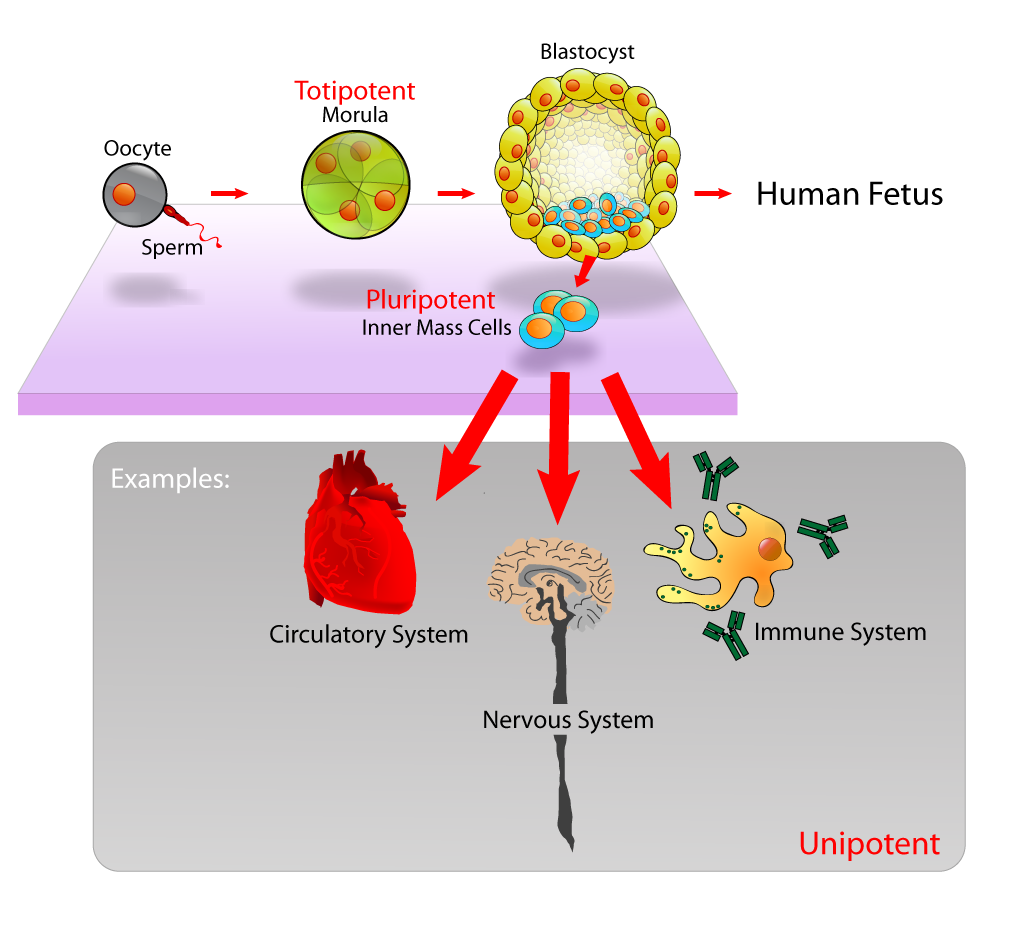
I learned this today. There are different types of stem cells, but they basically work by developing into different types of cells.
There are 200 different types of cells in the body, and they all do different tasks. For example, neurons in the brain, white blood cells that fight infection, muscle cells, and the cells in your skin. All of these reproduce, but they all had to come from somewhere. And that somewhere is a stem cell.
A stem cell becomes a different kind of cell by switching on or off different kinds of genes.
There are three different types of stem cell. Embryonic, adult, and induced.
Embryonic stem cells form when an embryo is three to five days old. At this stage, the embryo is called a blastocyst and has about 150 cells. All of these cells are called pluripotent stem cells. Pluripotent stem cells can become any other cell, or they can become more stem cells. This is how an embryo begins. Signals tell the cells which genes to activate or deactivate to tell them which cells to become.
The second type are adult stem cells. People continue to produce stem cells as they get older, but these cells cease being pluripotent and become multipotent. They can change into specific types of cell, and not any cell. They can make blood, skin, bone, cartilage, tendon, and some other cells. The cell that the adult stem cell can become seems to be decided by where in the body it is located. However, some recent research seems to show that adult stem cells can become some other types of cells.
The third type of stem cells are induced stem cells. These are stem cells that are made in a laboratory. Adult cells are removed and reprogrammed to become stem cells. They become pluripotent stem cells and can become any other type of cell.
Stem cells have a lot of possibilities, but they also come with a lot of problems. Let’s look at some of the problems first.
Embryonic stem cells are the cells most able to transform into any other cell, but they come with an ethical problem. They are obviously taken from embryos that would have had the potential to grow into humans. However, these embryos are made in a lab and they are never implanted in a womb, so they would have no chance of growing. Some people believe that human life begins at conception, which, to them, means that using the cells of an embryo means killing a life. Because of this opposition to embryonic stem cells, research into induced stem cells is vital.
Another problem is that just because the stem cell has the ability to change into any other cell, doesn’t mean that we have the ability to make it do that. If we want to make a heart muscle cell, we need to activate the correct genes, but that is not easy to do. We might end up making eye muscles.
Switching the cell off might prove difficult as well. If the cell keeps on producing heart muscles, it could become a tumor, with all the connected problems.
Yet another problem is our immune system. It is very likely that the immune system will attack stem cells because they are alien invaders. The only way to overcome this would be to use the cells of the person that is being treated. If a person’s cells could be engineered to become stem cells it would overcome all of the problems. But that is a long way off.
So, what are the benefits of stem cells? The main hope for stem cells is that they can be used to replace lost or damaged cells within our bodies. For example, if someone has diabetes, their body lacks insulin-producing cells. Those cells could be replaced with stem cells. Parkinson’s disease is caused by lost brain cells. Those cells could be replaced with stem cells. People with spinal cord injuries could have the missing nerve cells replaced. The possibilities are endless. However, to be able to do this, scientists need to work out how to change the specific adult’s stem cells into pluripotent stem cells and control them to become the cells that we want. That is not going to happen soon.
The idea of a stem cell was thought up in the late 19th century and the main elements of the stem cell were analyzed in the 1960s. In 2006, a team in Japan managed to convert fibroblasts (a cell that secretes collagen proteins) into pluripotent stem cells. And the research is ongoing. And this is what I learned today.
Photo Original work by Mike Jones for Wikipedia., CC BY-SA 2.5, https://commons.wikimedia.org/w/index.php?curid=1351705
Sources:
https://en.wikipedia.org/wiki/Stem_cell
https://www.yourgenome.org/facts/what-is-a-stem-cell
https://projects.sfchronicle.com/2018/stem-cells/about-stem-cells/
https://www.healthline.com/health/number-of-cells-in-body#human-cells
https://research.ucdavis.edu/wp-content/uploads/Stem-Cell-Research-Quick-Guide.pdf
https://www.mayoclinic.org/tests-procedures/bone-marrow-transplant/in-depth/stem-cells/art-20048117
https://www.unmc.edu/stemcells/educational-resources/prosandcons.html
https://www.ncbi.nlm.nih.gov/pmc/articles/PMC2726839/
